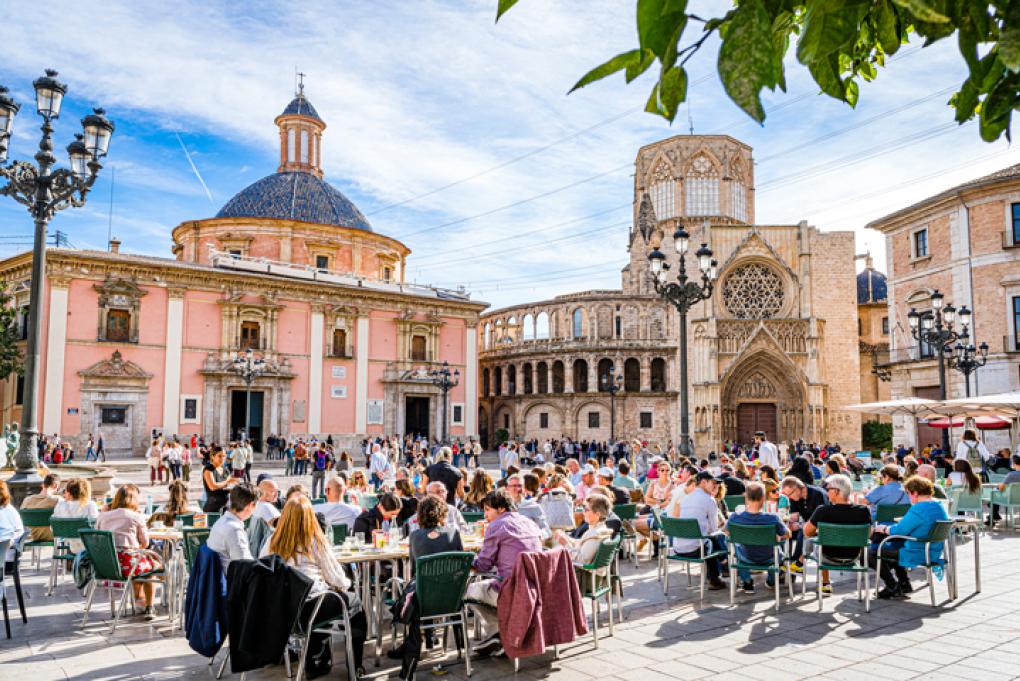A room with a view: city, beach or mountains
The sector is focusing on a strategy of diversifying its supply and addressing the weaknesses of the traditional sun, sea and sand model in order to maintain the leadership enjoyed by Spain in the global competitiveness ranking.

For years the tourism industry has been undergoing a complete transformation, moving towards higher quality tourism and making an effort to diversify its supply. Given the competitive edge enjoyed by Spain as a result of its geographical location, it is logical that the traditional tourism model, known as «sun, sea and sand», is the main driving force behind the country's tourism business. However, high seasonality, temporary employment contracts and a relatively low level of productivity are some of the weaknesses traditionally attributed to this type of tourism1. A strategy aimed at diversifying the tourism supply helps to address these weaknesses while strengthening Spain's position as international leader in the global competitiveness ranking.
Spain's sun, sea and sand tourism has been very popular with foreign tourists since the 1960s, with famous destinations such as the Canary Islands, Balearic Islands, Costa del Sol, Costa Blanca and Costa Brava. This kind of tourism accounted for 63.9% of overnight stays in Spain between January and October 20192. The second most important type was urban tourism, accounting for around 26.1% of tourist overnight stays, thanks to the dynamism of its four main destinations: Barcelona, Madrid, Seville and Valencia. Urban tourism has a very high level of productivity thanks to it being consumption-intensive. It also enjoys synergies with other types of tourism thanks to the fact that large cities tend to have better transport connections, often acting as a link between tourists' point of origin and their final holiday destinations. Lastly, 9.9% of demand is attributed to inland tourism. This segment is made up of a wide variety of types, such as historical, wine-related, religious and sports tourism. This kind of tourism is particularly interesting because it can help to generate wealth in less urban areas
- 1. See the article «International Tourism in Spain» in the Tourism Sector Report. 2nd Semester 2019 published at www.caixabankresearch. com.
- 2. The data used are from the Hotel Occupancy Survey produced by the National Statistical Office at a municipal level. We divided the sample into 48 «sun, sea and sand» municipalities, 14 «urban» municipalities and 44 «inland» municipalities. In case the sample was unbalanced (e.g. with sun, sea and sand destinations being overly represented), the relative weights of each type could be biased. However, through resampling we have been able to determine that these relative weights remained strong over time.
Urban tourism is highly productive as it is more consumption-intensive, while inland tourism is an effective means of generating wealth in rural areas
The three types of tourism in question have grown considerably in recent years, albeit at different rates. As shown in the following chart, urban destinations have grown significantly, increasing at an annual rate of 4.3% since 2006, while the sun, sea and sand and the inland destinations followed a similar trend, averaging 2.1% and 2.7% annual growth, respectively. Looking at the most recent period, we can see that demand for sun, sea and sand destinations stagnated in 2019. Specifically, overnight stays at coastal destinations fell by 0.9% year-on-year between January and October 2019, affected mainly by the decline in arrivals in the Balearic and Canary Islands. On the other hand, urban and inland destinations are expanding their demand at a considerably fast pace, both posting 6.2% year-on-year growth between January and October 2019. These figures show how the tourism industry has made progress in diversifying its supply, although the progress made is moderate in terms of market share, with sun, sea and sand destinations losing just 3.7 pp of their share in the past 14 years.
Overnight stays by type of tourism
Index (100 = January 2006), 12-month cumulative data

One of the reasons why coastal tourism is so important in terms of overnight stays is the long average stay at this type of destination. The data show that the average tourist who wants to spend a few days at the beach tends to plan a trip of about five days, while average stays at urban and inland destinations are much closer to a weekend tourist profile, with an average stay of 2.2 and 1.8 days, respectively. It is also highly revealing that the average length of stay is only decreasing for sun, sea and sand destinations. This indicates that the moderation in the average stay for Spanish tourism is not only determined by the growth in urban tourism (namely that short-stay tourism is gaining ground and therefore reducing the average length of stay overall) but also that the trend in sun, sea and sand tourism is towards shorter stays.
The strength of urban weekend tourism and a change in preference of sun, sea and sand tourists towards shorter stays are reducing the average number of overnight stays in Spain
The different types of destination also have different degrees of seasonality. Given its dependence on warm temperatures, sun, sea and sand tourism is the most seasonal with around 65% of tourist arrivals in the spring and summer. Both inland and urban tourism are less seasonal, concentrating 56.1% and 55.7% of their tourism in the spring and summer months, respectively.

Distribution of tourism throughout 2018 by destination type
(% of annual tourism)

It is clear that Spain's different types of tourism vary greatly in terms of their characteristics and trends. For instance, the trend in sun, sea and sand tourism has little in common with that of urban tourism but there is also a large amount of heterogeneity within each group. The sun, sea and sand group contains destinations such as Lloret de Mar, mainly focused on foreign tourists, and also municipalities such as Sanxenxo, aimed at domestic tourism. In the group of urban destinations are cities like Málaga, which has emerged as an urban tourism hub for sun, sea and sand destinations, as well as the city of San Sebastian, a more traditional urban tourism destination. However, the most heterogeneous group is that of inland tourism, including destinations focused on sports and leisure (such as Baqueira Beret) and also on historical and religious tourism (such as Santiago de Compostela), among others. In conclusion, we cannot say there is only one model of sun, sea and sand tourism or only one model of urban tourism, and of course there is more than one model of inland tourism.
Inland tourism is the most heterogeneous: it includes historical, gastronomic and wine-related tourism as well as sports and religious destinations. The seasonality of sun, sea and sand tourism and inland tourism is also heterogeneous, as it is affected by the location and the particular focus of each destination
The differences within each of these models are noticeable when looking at specific data from different tourist destinations. An analysis of the specific demand for each destination highlights differences between basic factors such as seasonality, the country of origin of the tourists they attract and the consumption profile of their visitors.
As far as seasonality is concerned, sun, sea and sand destinations are highly heterogeneous. At one end of the spectrum we find destinations such as Gran Canaria and Benidorm, with surprisingly low seasonality, while at the other end are destinations such as Sanxenxo, with over 62% of its demand in summer. Urban destinations are less seasonal in general, although their high exposure to domestic tourism, which tends to be concentrated in spring and summer due to the holiday calendar, may increase the importance of the high season to some extent. As far as inland tourism is concerned, the many differences detected depend on the tourism focus of each destination. Baqueira Beret, for instance, concentrates over 35% of its demand in winter while Granada has a higher concentration in spring, when temperatures are milder.
Distribution of tourism throughout 2018 by destination
(% of annual tourism)

Significant diversification can also be seen with regard to the countries of origin for inbound tourism at the different destinations. According to data on foreign card payments at CaixaBank payment terminals, collected from a sample of 20 tourist municipalities, the United Kingdom, Germany and France are the main countries of origin for sun, sea and sand tourists. However, as shown in the following table, this top 3 is not repeated in any of the destinations that have been analysed, demonstrating once again the great heterogeneity between sun, sea and sand destinations. The situation is similar for urban destinations, in which US tourists are particularly important. Inland tourism, on the other hand, is highly heterogeneous due to the great differences between the type of tourist activities carried out at its destinations. However, we can see that small historical cities such as Granada and Santiago de Compostela are very attractive for North American, French and British tourists.
Description of foreign tourist expenditure at the major sun, sea & sand, urban and inland destinations


Using data from payments made with foreign cards at CaixaBank payment terminals, we can apply machine learning methodology to group international tourists visiting Spain according to their spending patterns at the same 20 tourist destinations3. This exercise reveals a great deal of relative weight concentrated in just two types of tourists, who curiously have radically different profiles: the low expenditure tourist, made up of visitors with a very moderate average daily expenditure who have probably paid for part of their trip at origin (tour operator tourism), and what we have called the gold tourist, with a high level of expenditure aimed particularly at restaurants, fashion and jewellery. Only a few destinations show some diversification in this respect, as is the case of Sanxenxo, Marbella, Palma de Mallorca, San Sebastian and Baqueira Beret. This also makes sense, since specialisation in a single type of tourist can boost the loyalty of those tourists who have already visited the destination and help to attract new ones with the same profile.
- 3. A K-means clustering methodology has been used based on a series of variables describing the behaviour of foreign cards that reflect time, geographical and expenditure patterns. For more information on this type of analysis, see «International Tourism in Spain: from quantity to quality?» in the Tourism Sector Report. S2 2019.
Using machine learning techniques, we have grouped the card expenditure of international tourists at the same 20 tourist destinations. The most concentrated spending profiles are, curiously, the most diametrically opposed: the low expenditure tourist and the gold tourist, who spends money on restaurants, fashion and jewellery
In conclusion, the tourist destinations located throughout Spain have different degrees of seasonality, specialise in tourists of different nationalities and have a specific type of supply to satisfy the preferences of their own particular tourists. In other words, no matter what type of tourism the Spanish market attracts, we find that the tourist supply is already diversified to some extent.
However, continuing to invest in diversifying the tourism supply to an even greater degree will help to move towards more sustainable and higher quality tourism. The data show that diversification can make the sector less seasonal and optimise the geographical distribution of tourism, thus generating wealth in as yet undiscovered tourist destinations and resolving tourist congestion in popular destinations. Nevertheless, sun, sea and sand tourism will still be the mainstay of the Spanish tourism industry since, without this, it would be hard to understand the success of other tourism models, given the appeal and reputation that coastal destinations bring to the Spanish market. For this reason, the future of Spain's tourism industry depends on diversifying its supply, maintaining its strength in sun, sea and sand destinations but focusing on improving the quality of its tourism, be it on the coast, in the city or inland.
- 1. See the article «International Tourism in Spain» in the Tourism Sector Report. 2nd Semester 2019 published at www.caixabankresearch. com.
- 2. The data used are from the Hotel Occupancy Survey produced by the National Statistical Office at a municipal level. We divided the sample into 48 «sun, sea and sand» municipalities, 14 «urban» municipalities and 44 «inland» municipalities. In case the sample was unbalanced (e.g. with sun, sea and sand destinations being overly represented), the relative weights of each type could be biased. However, through resampling we have been able to determine that these relative weights remained strong over time.
- 3. A K-means clustering methodology has been used based on a series of variables describing the behaviour of foreign cards that reflect time, geographical and expenditure patterns. For more information on this type of analysis, see «International Tourism in Spain: from quantity to quality?» in the Tourism Sector Report. S2 2019.



